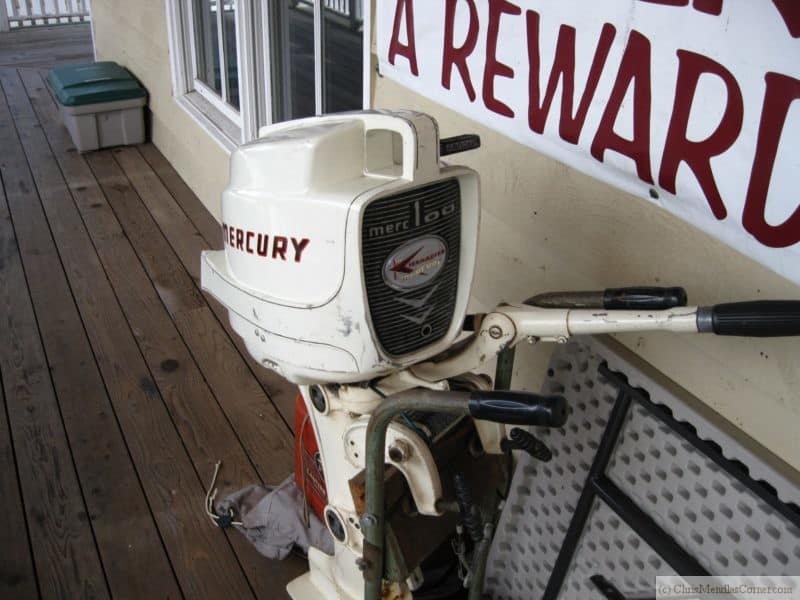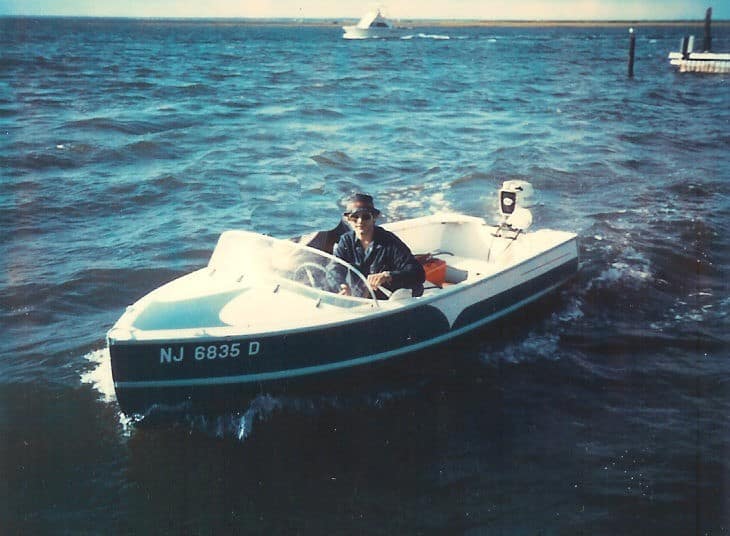Last Updated on 5 years by Christopher G Mendla
While visiting the Tuckerton Seaport in 2009, I saw a Vintage Mercury Outboard that was very similar to one I owned.
I purchased it well used. I had it on at least two 14′ boats. The engine pictured here has a tiller. My engine also had a remote throttle that allowed for a steering wheel. The steering was plastic covered wire cable which inevitably failed when the plastic got holes that let the wire rust. Yes, we used regular steel wire, not stainless. Most people kept the tiller handle attached so they could get home. In my case, the remote system required replacing the tiller with a disk shaped device that allowed for remote control. You could still steer the engine from the stern if you had to.
The engine took a 20:1 gas mixture. Environmentalists today would suffer a head explosion. The standard tank was six gallons. You would add a QUART of two cycle oil to five gallons of LEADED gasoline. Most people would have two tanks so one would be used as a reserve when you ran out.
To start it, you would make sure it was in neutral. Some engines could be started while in forward which would lead to interesting results. The next step was to squeeze the priming bulb on the fuel line until the carb was filled. It would often drain the fuel when the engine was tilted up. Then you made sure it was in neutral and the neutral throttle was advance. You also needed to manually set the choke which would provide a rich fuel air mixture for cold starting.
Electric start in those days was almost unheard of, even for the large engines. That was back in the days of Fiberglass boats and Iron men/boys. A couple of good pulls on the starter cord usually got things going. You had to play with the choke to open it before the engine flooded. With the 20:1 mixture, there was usually a nice cloud of white smoke until it warmed up. The smell is surprisingly pleasant. The engine pictured here is a 10 horsepower version. Mercury would ad a 0 to the horsepower so a 10HP would be a merc 100.
Once the engine started, you would check the ‘pee hole’. That was a small telltale stream of water that would let you know that cooling water was being pumped through the engine.
When you had the engine running, you were ready for a day of boating, clamming, water skiing or fishing.
Most of these engines did not have a battery. They worked on a magneto to power the ignition system. The engine I had used a kill switch with a rubber cover. Unfortunately, the rubber cracked and I never got around to replacing it. I did a lot of clamming and water skiing, both of which got you wet. Picture being soaked in salt water, standing in salt water on the deck, and getting zapped with the 10,000 volts from the coil. It was a contest to see if I would let go before the engine died. Young and dumb. …
Most engines above about 20 HP had forward, neutral and reverse gears. However, there was a 100 hp Mercury in the 1960’s know as a Suicide Merc. It was an engine designed for racing. There were no gears in some models so when you started it, it was in gear. There was no reverse or neutral. Other models supposedly had a direct reversing engine where, in order to change from forward to reverse, you had to shut the engine off, switch to reverse and then restart it. That resulted in a number of bulkhead vs. boat scenarios.
In those days, the Keikaffer/Mercury had a large share of the market. The other two brands were Evinrude and Johnson. You could start a religious war by arguing which was the best. There was also a four cycle engine by Homolite.
Things were a lot different in the 60’s. My friends and I all had similar 14′ outboards with 20 horsepower engines at about 12 years old. We would go out in Little Egg Harbor for a day of boating. The only rules were to not go into the inlet. We would jump wakes from the larger boats, water ski, fish, and clam. Those were days before cell phones. In fact, many of the shore homes didn’t even have a landline. People used a neighbor’s phone or the payphone at the arcade. There was also no requirement for any type of operator’s license. All you needed, if you had an engine, was the state numbers and registration decal.
It is a bit disconcerting to see something you used as a kid in a museum…
Here is a photo of the engine I had on a wooden boat. I was selling the boat and motor at the time.
My engine had the rotary throttle/shift control.
Here is a YouTube video of someone starting a similar engine in a tub of water.


